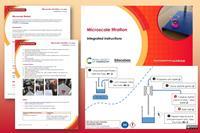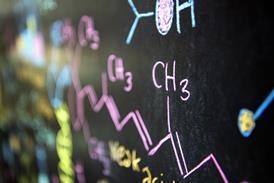Introduce titration without the cognitive load of a full-scale set up
This microscale practical involves uses simplified equipment and small quantities of chemicals to understand the basic principles of a titration.
Microscale titrations can be gravimetric (measuring the mass of the reaction vessel before and after) or volumetric (measuring the volume by counting the drops of solution added). Following integrated instructions, learners will carry out a simplified volumetric or gravimetric titration.

Download this
All the information you need to prepare, set up and run this experiment with your learners:
- Technician notes as pdf and MS Word
- Integrated instructions as pdf and MS PowerPoint
- Integrated instructions (Welsh) as pdf and MS PowerPoint
Learning objectives
- Make accurate observations for the end point of a titration.
- Use your observations to infer what is happening during a titration.
Equipment (per group)
- 1 x beaker, 10 cm3 or small vial
- 1 x white tile
- 1 x clamp stand
- 1 x plastic pipette (preferably a fine-tipped pipette)
- 1 x measuring cylinder (10 cm3)
- 1 x mass balance (to 0.01 g)
- Vinegar solution (shop-bought, diluted by a factor of 4), 1 cm3
- Phenolphthalein solution (0.05%), 1 drop (WARNING: flammable)
- Sodium hydroxide solution (0.2 mol dm-3), 10 cm3 (WARNING: irritant – skin and eyes)
Safety equipment
- Eye protection: safety glasses to EN166F
Health, safety and technical notes
- Read our standard health and safety guidance and carry out a risk assessment before running any live practical.
- Refer to SSERC/CLEAPSS Hazcards and recipe sheets.
- Hazard classification may vary depending on supplier.
Read the technician notes for full safety information, preparation and disposal.
More resources
- Our microscale collection has more information and tips, plus lots more microscale experiments.
- Find out how to help students build their confidence in quantitative chemistry calculations.
- Download this titration apparatus infographic to familiarise students with the equipment involved in a full scale titration.
- Find out how Taryn uses analytical techniques to test food, pharmaceuticals and raw materials.
Method
Gravimetric titration
- Add 1 drop of phenolphthalein to the small beaker and record its mass.
- Using a measuring cylinder, measure out 1 cm3 of diluted vinegar and add it to the beaker. Record its mass.
- Fill the plastic pipette with NaOH solution and clamp it gently.
- Place the beaker below the pipette.
- Carefully tighten the clamp to add one drop of NaOH solution to the beaker at a time.
- Swirl the beaker.
- Add NaOH solution dropwise until a permanent pink colour is formed.
- Record the mass of the beaker.
Volumetric titration
- Add 1 drop of phenolphthalein to a small beaker or vial.
- Add ~1 cm3 of vinegar to the same beaker.
- Fill a dropping pipette with sodium hydroxide solution (around 0.2 M).
- Clamp the pipette gently.
- Tighten the clamp carefully until 1 drop of NaOH is added to the beaker/vial.
- Swirl the beaker/vial.
- Repeat steps 5 and 6 (counting the number of drops added) until a pale permanent pink colour is seen.
Disposal
Rinse the aqueous solutions down a foul-water drain with plenty of water.
Downloads
Microscale titration technician notes
Handout | PDF, Size 0.3 mbMicroscale titration integrated instructions
Handout | PDF, Size 0.48 mbMicroscale titration integrated instructions Welsh
Handout | PDF, Size 0.47 mbMicroscale titration technician notes
Editable handout | Word, Size 1.22 mbMicroscale titration integrated instructions
Editable handout | PowerPoint, Size 0.52 mbMicroscale titration integrated instructions Welsh
Editable handout | PowerPoint, Size 0.52 mb
Additional information
This resource is based on a method developed by CLEAPSS, PP019 Analysis of vinegar (small scale), available from the CLEAPSS science website.


















No comments yet